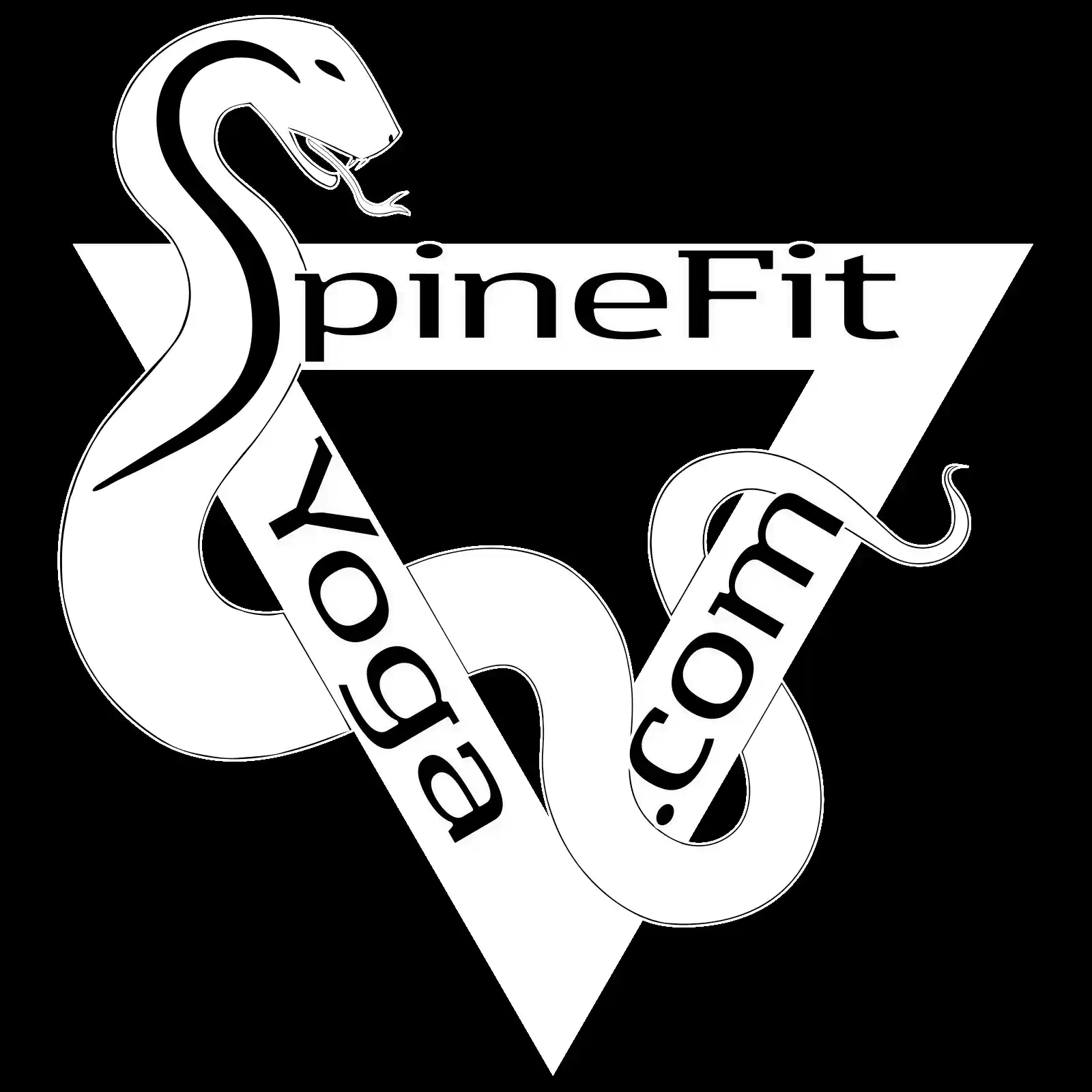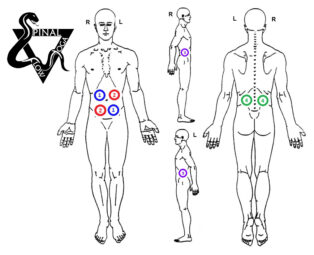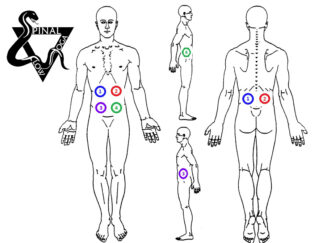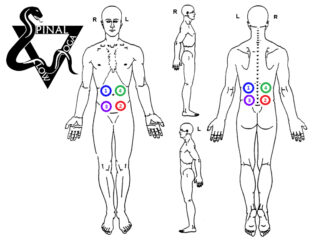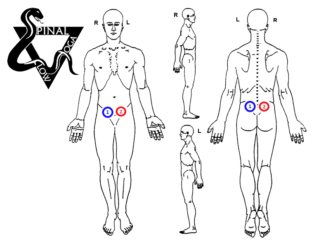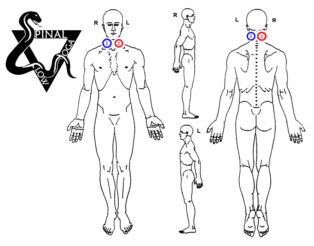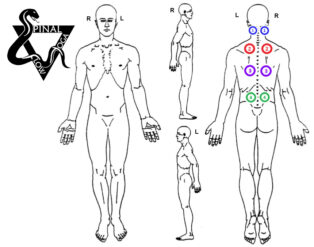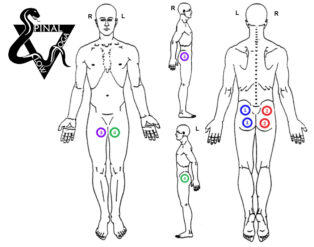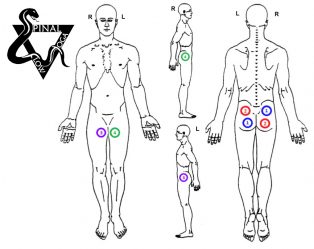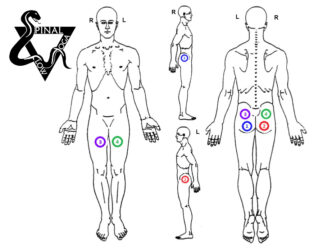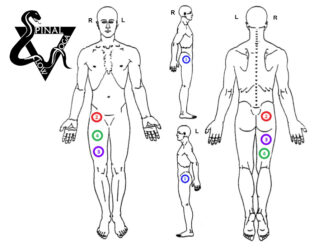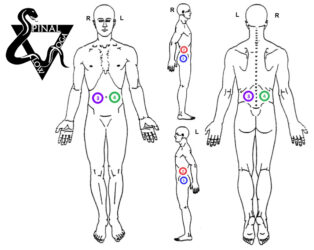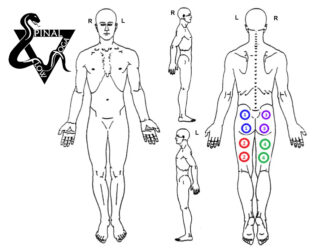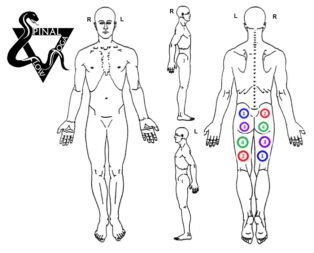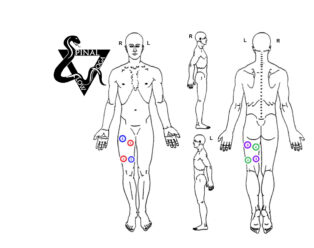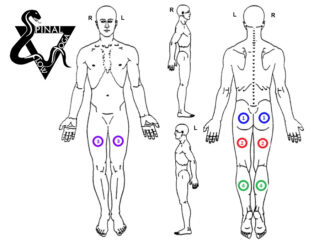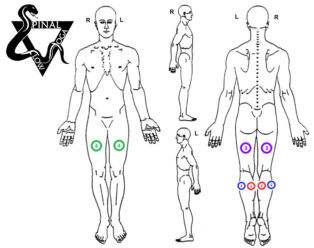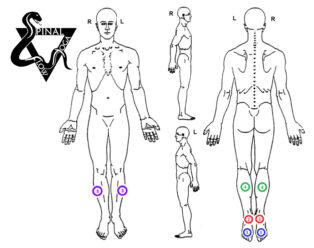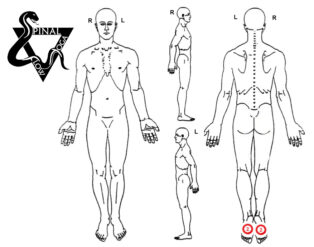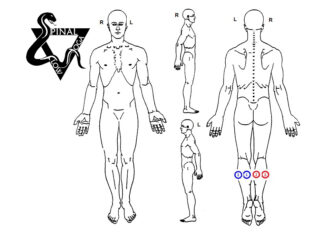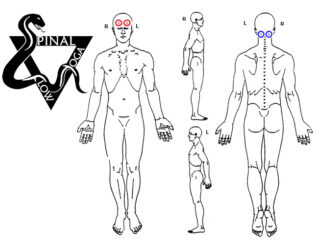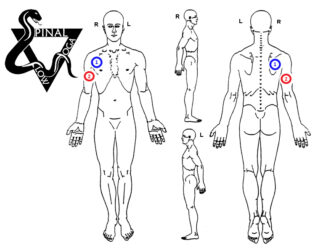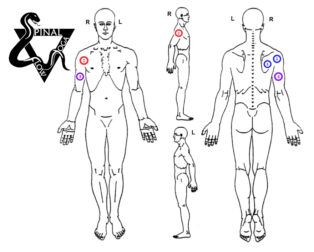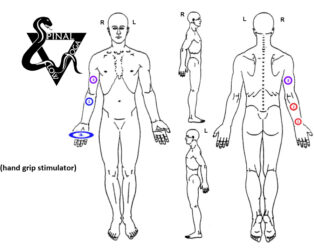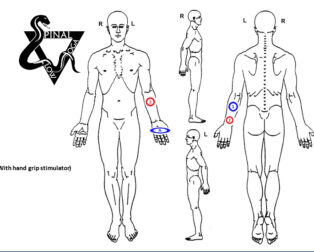Electric Stimulation Pad Placements
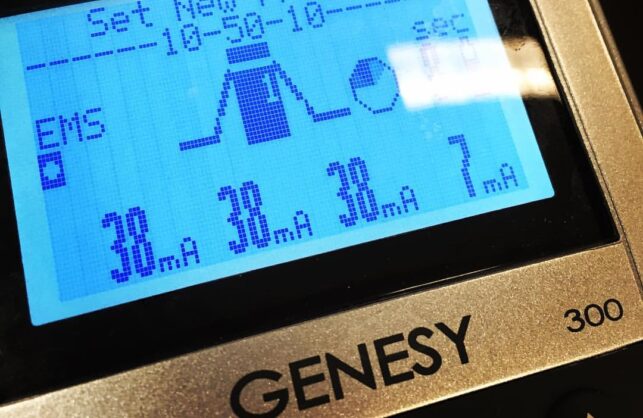
Electric stimulation for increasing muscle strength, circulation, and decreasing pain is something I very much believe in. However, EMS for me is currently on the back burner, with this page supporting my older physical therapy related blogs on electric stimulation. I’m hoping to one day work this in with SpineFitYoga, as I think electric stimulation (EMS especially and less so TENS) has tremendous potential to help people with more severe neck and back pain, rapidly and substantially decreasing pain, while at the same time increasing spine stabilization strength, so that you can better perform the rest of SpineFitYoga. However, I don’t want to push it that hard because SpineFitYoga is awesome as is. Still it’s the truth that, IF DONE PROPERLY can absolutely accelerate progress, perhaps being particularly effective especially for those with fibromyalgia, central sensitization, or chronic widespread pain type symptoms, who need more than exercise to get the ball rolling. EMS is also especially helpful in restoring muscle symmetry between right and left sides if a bulged or herniated disc causes especial weakness in one arm or leg.
However, writing more about electric stimulation is on the back burner for me as I build out the rest of SpineFitYoga. This is because several reasons:
- Obtaining quality, fairly priced, electric stimulation machines, and electrodes/straps that work with them is currently a fiasco in the USA. A fiasco that I don’t presently have time to deal with.
- Electric Stimulation, while effective, and for some is crucially important, for most isn’t nearly as important for fitness, nor for decreasing neck and back pain as learning SpineFitYoga’s M5 and getting good at M5.
- If you just do electric stimulation on your neck and back, you’re just going “feel better” in the short term, and maybe even have stronger core muscles. However, you will probably continue to degenerate your spine, leaving you with the same amount of pain in the long term.
- Electric Stimulation with equipment good enough to help, is considerably more expensive than doing SpineFitYoga, with an ideal set up costing a few hundred dollars (if you pay thousands you’re really getting ripped off), while SpineFitYoga is only $20.
- Some of what I teach regarding electric stimulation is controversial. While, I’m confident that I’m right and everyone else is wrong, if enough people use my methods, I help a million and hurt one, even if merely by chance, someone’s likely to make a big deal out of the one. So know this, I’m describing EMS as I do it, or did it, I’m not telling anyone else they should do the same. Copy at your own risk. I don’t have a pacemaker, and I would not do EMS or TENS if I did without clearing it with my cardiologists first as medical literature reported dangerous and painful interference.
- Last, as much as I like EMS, I like the idea of SpineFitYoga, doing it all, all by itself, even more.
All that said, I’m a unique voice in the field of electric stimulation. I’ve been blogging on the subject for years, and I did a year long self-experiment where electric stimulation was my only form of exercise. As far as I know, I’m the only person to have ever done that (my notes here). In doing so I was able to directly apply what I was learning on myself, to see and feel what worked, what didn’t, as well as advantages and disadvantages in comparison to conventional exercise. At the same I was able to apply what I was learning to most of my patients in conjunction with their exercise programs in my physical therapy office. In doing so I was able to give electric stimulation a shot for anything I thought it might help with, which was a lot of varying diagnosis.
Unfortunately, I’m one person, and I don’t presently have time to devote to answering more technical details about electric stimulation, what machines to get, where to get them, where to source electrodes and straps, etc. A lot can be learned by reading my older blogs on electric stimulation, and I have some older videos from when I was still doing physical therapy on my youtube channel. If you feel you must talk to me about electric stimulation, or anything else, I do phone consultations for $200 a talk. Again, SpineFitYoga Membership is only $20 for a year.
Anyway, below are my favorite EMS electrode placements. I’m adding a “Chad’s Rating,” my subjective 0-10 scale, with zero being worthless (for which I don’t think I’ll bother to list) and 10 being the best thing ever. If I rate something higher than an 8/10 I’ll say that’s better than conventional exercise (for that isolated muscle group or body part only).
Core-1 (EMS for low back pain, abdominal/core strength)
Chad’s Rating: 9/10
Brief Description:
Core-1 is my favorite EMS pattern to get started either for abdominal strengthening and/or immediately and substantially decreasing low back pain. This pattern trains all abdominal muscles stabilizing the low back including rectus abdominis (the six-pack), obliques, transverse abdominis, plus the spine extensors all at the same time. Because the EMS channels 1-4 are separated per region, you can go harder on low back (channel 4), less so on anterior abdominals (channel 1-2), and intermediate on obliques (channel 3), which at first is what almost everyone prefers. The first time I did Core-1, I thought, “If I turn this up any higher, I’m going to have a hernia right now! Any more and it will tear my muscles.” Fortunately, you get used to it. However, EMS is like exercise, if you don’t go hard, it’s not going to do much.
Core-2 (EMS for low back pain, abdominal/core strength)
Chad’s Rating: 10/10
Brief Description:
Core-2 is my favorite EMS pattern for advanced abdominal strengthening and decreasing low back pain. Like Core-1 this pattern trains all muscles stabilizing the low back at the same time. The difference is the channels are criss-crossed, thus spaced further apart, allowing for deeper stimulation, stronger, and more unified muscles contractions. However, because the electrodes of each channel are criss-crossed, you lose the ability to target specific muscle groups with greater or lesser intensity. Meaning you can’t go harder on your low back, perhaps to further decrease pain, without overwhelming your anterior abdominal muscles. After several weeks of training the anterior abdominal muscles have usually toughened up, so that they can handle as much stimulation as your sides or back. During the EMS blast with Core-2 it should feel like you are being crushed by an anaconda, literally.
Core-3 (EMS for low back pain, abdominal/core strength)
Chad’s Rating: 8/10
Brief Description:
Core-3 I rarely use, preferring to get the side abdominal (oblique) muscle contractions of Core-1 and Core-2. With Core-3 you are trading off the oblique muscle stimulation to get an additional 2 electrodes on the spine extensors. I’ll do this if the person’s low back pain is higher up than usual (upper lumbar/lower thoracic region). You want to make sure the electrodes are all below the ribs, keeping the stimulation away from the heart. The other reason I might use this pattern would be for post-pregnancy, in women with diastasis recti, where I would want to strengthen her anterior abdominals and low back, but not have her transverse abdominis and oblique muscles pulling so hard and potentially overstretching the already increased gap between both sides of her rectus abdominis muscle. With Core-3 it feels like you are being squished, front to back, in a vice.
TENS for Dysmenorrhea (Menstrual Cramps)
Chad’s Rating: ?, not enough feedback to judge
Brief Description:
I don’t have a lot of experience with this one (obviously, haha). But I have read several papers on TENS for dysmenorrhea. It’s not so much that I’m interested in women’s health, but for a time was interested in all things EMS/TENS and this came up in the research. Plus my office staff at the time was largely female, and they wanted to try it. The following pad placement is what they liked best and they said it helped. Relief seemed to last only when the electric stimulation was applied, so I would think you would want a smaller 2-channel stimulator like the TwinStim IV, that could be clipped on the belt and warn longer. Being on longer, I think you would want to do lower intensity TENS as opposed to high intensity EMS.
However, notice that the electrode placement is about the same as the lower pads on all my core placements? It makes me think that if dysmenorrhea has a central sensitization component (from having hurt so long, over so many years) that Core EMS done regularly (every third day I think is ideal) and intensely, might over time lessen pain from dysmenorrhea. This is just a theory, however it would jive with what I have observed with chronic migraine sufferers. Where those who did my headache EMS program several times a week, even when they did not have migraines, steadily reported a lessening in both frequency and intensity of migraines, eventually to the point of being cured. Dysmenorrhea is not the same I’m sure, but I suspect some parallels. Thus if anyone wants to report back with their experiences I would love to hear it.
EMS for Neck Pain and Weakness
Chad’s Rating 10/10
Brief Description:
Everyone will tell you not to stim the neck, particularly not the front of the neck, saying it’s a “contraindication.” However, in spite of what electric stimulation textbooks, and the manual that comes with your stimulator says, electric stimulation is not a contraindication. It’s merely a “precaution” that’s been there since the 70s and nobody has bothered to confirm or deny. Since the 70s I have been able to locate zero case reports of anyone being injured by doing so, despite a fair amount of research, outside the field of physical therapy and fitness suggesting it is safe. I’m not saying it’s safe, but I have been doing it to myself (aggressively) for years, and for years to my patients (much less aggressively). In doing so, I got measurable neck muscle hypertrophy and my neck muscle endurance tripled. My patients reported subjective increases in neck strength, endurance, stability, range of motion, corresponding with usual immediate and substantial pain reduction. Like 6/10 pain being reduced to 1-2/10 on the first try (with the right machine, right pads, right program, right intensity), with the pain reduction usually lasting at least a couple days.
I’ll add that while I have not used electric stimulation to treat dysphagia (difficulty swallowing) post stroke, I’m familiar with parameters used by the VitalStim unit, promoted to speech therapists for that purpose. My thoughts are that the VitalStim manufacturers don’t know the first thing about electric stimulation for improving muscle performance, including the swallowing muscles, and it shows in the dismal results in independent research of their device. Still I think the concept has merit, and I’ll add that it’s my recollection that the TwinStim IV has more than twice the power, and infinitely more versatility with regards to programming, at roughly 1/20th the cost. Yes, one twentieth; as I said electric stimulation in the USA is a fiasco.
Full-Spine TENS for Pain
Chad’s Rating: 7/10
Brief Description:
This placement being unbalanced not ideal for EMS. However, for TENS it often results in remarkable pain reduction, particularly in those affected with chronic widespread, central sensitized, fibromyalgia like pain. Those patients for whom even the lowest intensity exercise with good postures exacerbates pain making them afraid to try any exercise. My FM-TENS program with this placement this feels pretty amazing even if you don’t have pain. It’s unfortunately difficult to self apply the electrodes, but with straps, and laying flat on one’s back, sans pillows.In those with pain “everywhere” that prevents even good exercise from helping. FM-TENS to the entire spine, gradually adding EMS to the hips, legs, and core is generally very well tolerated. Intermittent fasting helps too, and starts decreasing weight, and systemic inflammation without requiring any physical exertion. Gradually adding P5 to learn good posture and coordination with minimal exertion and progressing to M5 to at last build strength and endurance is what I would do if it were me in a worst case scenario (anxiety, depression, overweight, widespread pain seemingly everywhere). I’ll have more to say on this later.
Hips-1: EMS for increasing global hip strength
Brief Description:
Chad’s Rating: 6/10
Brief Description:
Hips-1 was a surprisingly effective stimulation pattern I discovered in my year of EMS. Compression shorts helps hold the electrodes in place, but I put my elastic straps over the shorts keeping the electrodes as tight to the skin as possible. I use only rubber carbon electrodes for which you want to always keep them tight, and very wet with tap water, because if contact is poor they’ll sting. The inner thigh electrodes from channel 3 and 4 are to be placed inside the thigh, as high up as possible, NOT facing the front as shown in the image.
Hips-2: EMS for increasing global hip strength
Chad’s Rating: 7/10
Brief Description:
Hips-2 is the same as Hips-1 but there is more criss-crossing of the electrodes, getting each channel further from each other for deeper stimulation. Hips-2 does feel better to me, but like Core-2 it’s better after you have been doing EMS for a while and all your muscles are conditioned to tolerate the same intensity of EMS. Otherwise some muscles will either feel overworked or underworked. And yes, EMS hit hard enough it can strain/injure muscle, tendon and ligaments if you overdo it. That said, overdoing it causes a LOT of sensation, so is very unlikely to happen by accident, and all EMS machines I like ramp up slowly and steadily, making overstimulation unlikely.
Hips-3: EMS for increasing global hip strength
Chad’s Rating: 9/10
Brief Description:
Hips-3 is the same concept (criss-crossing electrodes) as Hips-2 but taken even further, for maximal depth of muscle contractions. The difference is noticeable making this my new go-to pad placement for hip musculature, leading changes in feel during stimulation, next day muscle soreness, and fatigue. That said, if you can work up to the Level-3 Lunges of M5, you’ll probably not feel any hip or leg EMS is necessary.
Still I think this can be an adjunct if you have gluteal muscle damage, which I believe results from too long of sitting. This is what I think Stuart McGill is referring to when he talks of “gluteal amnesia,” however I think it’s more of a pressure induced muscle fiber injury or nerve palsy. This might show up when performing Lunges of M5 as both a poor number and knee pain, resulting from a relative overuse of quadriceps (front thigh muscles) having to extend the knee, because the glutes are not pulling their weight (literally) to extend the hips thus insufficiently assisting in what should be a compound knee and hip exercise. If combining hip EMS with lunges I would definitely do them after Lunging but on the same day. This is to minimize glute fatigue during Lunges (which would only worsen quadriceps over-utilization in the near term) and allow for the longest recovery time before Lunging again 3 days later.
Hip-Thigh EMS
Chad’s Rating 4/10
Brief Description:
Hip-Thigh is placement I rarely use. Hips 1-3 work better for hips, and Basic Thigh works better for quadriceps and hamstrings. However, Hip-Thigh is worth using for someone who has recently had a large and painful lumbar disc herniation causing pain and weakness in one of the legs. Also EMS to the weaker side, is a good way to prevent pain from becoming weakness on the affected side. After the disc inflammation calms down, and the body starts to reabsorb the fragment, leg pain should diminish so that active exercise (P5 and M5) can be initiated. Ideally in such situations the person would be doing Core EMS 1-3 concurrently. Unfortunately, EMS and TENS doesn’t work as well for pain during an acute disc blowout, as it does when people have chronic/recurrent pain, but usually helps some for pain. I don’t expect “miracles” with it quite the same as I do with chronic pain, where people are often like, “wow!”
EMS for Trochanteric “Bursitis”
Chad’s Rating: 3/10
Brief Description:
“Trochanteric bursitis,” is almost never bursitis, but is gluteal or trochanteric tendinopathy, hopefully not progressing to muscle tearing. That said, bursitis is what everyone thinks it is, and in my experience EMS helps restore strength to the affected muscle, and helps reduce pain at the same time. If you have your own machine, running one of the Core 1-3 programs, followed by the Hip 1-3 programs is better, but if you are in physical therapy and have time to run only one program, this pad placement is a fair compromise. The real exercise of M5 is almost certainly better also, but if you have the means, EMS afterwards should accelerate progress. If you have the greater surface area of the giant 5×8″ electrodes rubber carbon electrodes, this placement is fairly fantastic all by itself, which is how I did it in my office. The lower 3/10 rating reflects that M5 still works better and only takes 5 minutes to finish.
Glute-Hamstring-1: EMS for glute and hamstring circulation and hypertrophy
Chad’s Rating: 6/10
Brief Description:
This is probably one of the better electrode placements to prevent, and/or recover from pressure ulcers in someone in a wheelchair (likely only if they have spasticity). Unfortunately, this only works if the connection between the muscle and the lower spine is still intact (because of an injury higher in the spine). If it works, this placement should both improve circulation skin and muscles, as well as increasing muscle mass, thus taking pressure off the sit bones. In such situation I would very likely want to use one of my combination programs where I combine the strengthening of a 10-50-10 or a 5-15-10 program with a 5 hz aerobic EMS program turned up during the rest period between EMS blasts. Otherwise you would have to run two separate programs to get both effects, which isn’t the worst thing in the world.
Glute-Hamstring-2: EMS for glute and hamstring circulation and hypertrophy
Chad’s Rating: 6/10
Brief Description:
Same intention and purpose as the above, however the electrodes are criss-crossed getting each end of a channel further from its sibling, increasing the depth of muscle contraction. Generally this is desirable, but like my other criss cross placements you lose the ability to localize exactly where you want a weaker or stronger muscle contraction.
Basic Thigh: EMS for Quadriceps and Hamstring Strength
Chad’s Rating: 7/10
Brief Description:
This is my absolute go-to thigh placement. If I’m rehabilitating a knee after almost any surgery. Or if one leg has arthritis or some injury that does not let me train it as hard (or at all) with regular exercise I’ll very likely use Basic Thigh. Placing 2 sticky electrodes on the quadriceps for some mild “tingling” is a joke, when instead I can strap 4 large criss-crossed rubber carbon electrodes on the same quad, and while I’m at it, put another 4 criss crossed electrodes on the hamstrings. The balancing of quadriceps and hamstrings gives you AT LEAST double the overall strength and endurance. Wherefore the co-contraction of the EMS balances forces, lessening shear stress about the knee while you are at it. Knee pain should be reduced more also, per my experience in the physical therapy office, and per gate control theory.
Aerobic EMS
Chad’s Rating: 7/10
Brief Description:
This electrode placement is what I used experimenting with aerobic conditioning with EMS. To make it work I needed the giant 5″x8″ electrodes. The extra wide electrodes very much dispersed the current density (how much electricity is going through each square inch of electrode allowing me to tolerate overall higher levels of stim) and sibling electrodes being on alternate legs allowed for very deep stimulation. My heart rate did hit aerobic levels. I was both breathing hard and sweating. It was not comfortable and I would have preferred real exercise. However, for someone who otherwise can’t exercise, and for those whom diminished sensation lessens pain, this could be the best option. Also, when I was testing it for my blog, I was going as hard as I could to get my heart rate up, less intensity, just getting the muscles twitching still improves circulation.
Anti-Blood Clot, Deep Vein Thrombosis EMS
Chad’s Rating: 8/10
Brief Description:
This pattern is what I have used for post total hip, and other surgeries to lessen risk of deep vein thrombosis (DVTs), based on this blog/research. What’s cool, is that a good EMS machine can easily be programmed to strengthen muscles as well as improve circulation. Both legs are being stimulated because research has blood clots sometimes form in the non-operative leg due to post surgical inactivity. I would suggest asking your surgeon about this, perhaps being able to hand him the paper cited in my blog.
Neuropathy or Plantar Fasciitis EMS
Chad’s Rating: 9/10
Brief Description:
EMS for neuropathy works considerably better than expected. With patients of mine reporting 8 or 10/10 pain decreasing to 0/10 pain, frequently, if not usually after EMS treatment with my 10-50-10 or 5-15-10 programs. Since I’m not treating people in the office anymore I’m unable to test my latest ideas on neuropathy. I’m all but positive that the combination of the above mentioned EMS programs, with 5 hz, aerobic EMS programmed into the rest period would work even better. Also I used to stand on the electrodes, and have my patients do the same based on what Sprint Coach Charlie Francis said he did (which is where I learned the best info besides self experimentation) to prevent foot cramping. If you have neuropathy, probably you should do M5, at least level-1, maybe you should think about intermittent fasting, but I’ll bet a million dollars that EMS works a lot better, a lot faster. It’s one of the few instances where EMS is far ahead. See the basic foot EMS placement below, because it’s simpler and may be sufficient.
Foot-1 EMS
Chad’s Rating: 10/10
Brief Description:
This simple placement has become my go-to pattern for intrinsic foot muscles. If the EMS machine is powerful enough, and nerves healthy enough you can feel and strengthen everything up to knees level. The electrodes being so far apart (the length of both legs) causes the current to run VERY deep. Thus when trying to rehab my own foot injury, I used this pattern in sitting with 5-15-10 and 10-50-10 and it felt very strong, but not unbearable in sitting. However, it certainly took some getting used to. Because of simplicity and speed of application this would be the first placement I would try for neuropathy or plantar fasciitis also, posterior tibial tendinopathy, or any time I wanted to strengthen the muscles within the foot, and even calf musculature.
Calf EMS
Chad’s Rating: 3/10
Brief Description:
This is very strong EMS, and arguably too strong. Such that I required something fixed (like a leg press machine or the other side of a hallway) to brace the ankle against during the blast to prevent extraordinary cramping. The need to brace the ankle makes real exercises, calf raises, either in the gym or as I teach them in SpineFitYoga’s M5 preferable. However if there is nerve damage, either in the leg, or in the spine from a herniated disc, EMS to the affected side, combined with real exercise should restore strength faster. Merely standing with bodyweight on both or even one foot is not enough if your calves get strong, but is often good enough when still weakened.
Headache EMS
Chad’s Rating: 10/10
Brief Description:
I think it would be most logical to present my EMS patterns top down, from head to feet. However, I don’t want to start out with my most controversial placements, even if it is one of the best. Notice these electrodes are NOT criss-crossed, and ARE right next to each other, almost touching, as I DON’T want deep stimulation. I want to keep the stimulation superficial, which in my experience works extremely well for both tension headaches, occasional migraines, and even chronic migraines. Definitely, read everything I have written regarding headaches and electric stimulation, and see that this is evidence based. Fortunately the head is sensitive so that people don’t need to go as high for benefit, and can’t go as high, because high intensity stim on the forehead is intolerable. EMS for headaches, and neuropathic pain are the closest thing to miracle cures I am aware of. That’s using my programs and large rubber carbon electrodes, which I think is why my results are so much more dramatic than in the research.
Basic Shoulder: Electric Stimulation
Chad’s rating: 3/10
Brief Description:
I don’t love EMS to the shoulder, or any arm muscles actually, but I’ll list a few placements because sometimes they are necessary, and helpful. The difficulties in strapping the electrodes in place, especially on yourself, makes conventional exercise generally preferable. This pad placement is simple enough, targets most of the rotator cuff, as well as the upper arm, and can decrease pain while helping to restore lost muscle strength. In the clinic would often use TENS programs like this to lessen pain, but light enough intensity to avoid muscle contractions early post shoulder surgery.
Frozen Shoulder: Electric Stimulation
Chad’s Rating: 4/10
Brief Description:
Similar to the above but with an extra channel, thus hitting the rotator cuff and deltoid harder. While for most shoulder conditions I think EMS is of only moderate utility, for frozen shoulder (aka adhesive capsulitis) I’ve had both EMS and TENS work very well, decreasing pain well enough my patients could avoid both NSAIDS and cortisone injections, better tolerate the stretching necessary to restore normal range of motion. For frozen shoulder I have used both my FMTENS to decrease pain quickly progressing 10-50-10 or 5-15-10 EMS programs to increase shoulder strength while still decreasing pain.
Whole Arm EMS
Chad’s Rating: 3/10
Brief Description:
This is a stim pattern that I would likely do for rehab after an injury to one side, or if there were nerve damage causing weakness to that side. Though I did it on myself for a year as part of my experiment and it worked, in my experience lifting weights or doing M5 is better. “Hand grip stimulator” means hand grip “electrode” which is a specialized electrode for delivering the electric stimulation to the palm of the hand. I have had this work very well in people with neuropathy of the hands, sometimes seen in diabetics. I’ve used this for tennis elbow, golfer’s elbow, aka shooter’s elbow in the population I saw most, but I would say the exercise alone is responsible for 90% of the recovery.
Electric Stimulation for De Quervain Syndrome
Chad’s rating: 3/10
Brief Description:
This electrode placement has worked well with my patients after strengthening exercise of the arms and wrist muscles, very similar to the protocol used in my shooter’s elbow treatment. Followed by what’s at first a painful stretch, mimicking the Finkelstein’s test. I would do my 10-50-10 or 5-15-10 programs as tolerated, and I have had patients, within 2-4 weeks be pain free and their bad arm stronger than their good arm. As above “hand grip stimulator” denotes a hand grip electrode.
